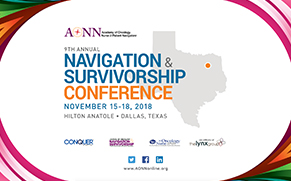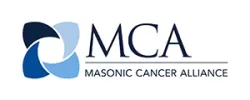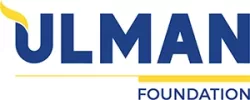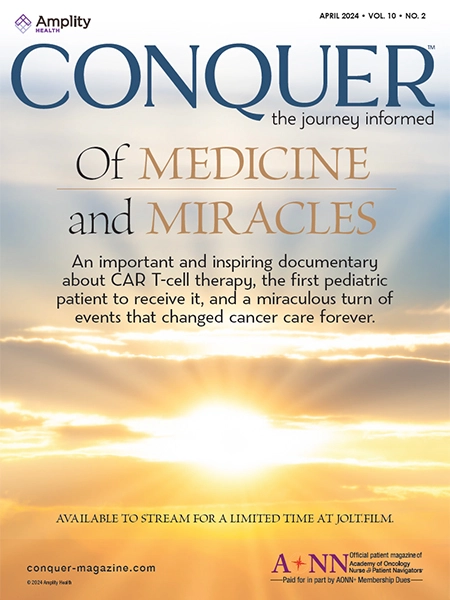
The AONN+ Ninth Annual Navigation & Survivorship Conference kicked off without a hitch as close to 1000 attendees rode into Dallas to learn, network, and enjoy all the event’s offerings. After a record-breaking number sat for the certification exams, AONN+ leaders provided a resounding “Howdy” to the eager multitudes. From there, the navigators dispersed to pursue a variety of sessions on their individual areas of interest, including disparate populations, clinical trials, and much more. With the event shaping up to be the best AONN+ Annual Conference thus far, it’s no wonder that the saying goes, “Don’t mess with Texas!”
Attendees Seize Opportunity to Further Careers by Taking Certification Exams

Unique to the field of navigation, AONN+ certification provides the competitive edge of standardized expertise, treatment optimization, career enhancement, and recognition as an integral member of the multidisciplinary oncology team. With this in mind, nearly 200 attendees of the AONN+ Ninth Annual Navigation & Survivorship Conference—almost quadruple the number from last year’s conference—made it their goal to join the ranks of the more than 300 AONN+ members from over 130 institutions and 9 advocacy groups across the nation who have earned the AONN+ certifications by taking the necessary examinations. The excitement was tangible among those who sat for the exams. Now that their work is complete, the credential seekers only need await their results, which should arrive just ahead of the holidays—the ultimate gift for a navigator.
Consisting of Oncology Nurse Navigator–Certified Generalist℠ (ONN-CG℠), Oncology Patient Navigator–Certified Generalist℠ (OPN-CG℠), and Oncology Nurse Navigator–Certified Generalist (Thoracic)℠ (ONN-CG[T]℠), the certifications were created in response for the call to have credentials specific to oncology navigators and their particular knowledge and expertise. Each comes with its own set of educational criteria and curriculum.
As of now, the ONN-CG℠, OPN-CG℠, and ONN-CG(T)℠ certification exams are only available twice each year—at the AONN+ Midyear Conference in the spring and at the Annual Navigation & Survivorship Conference in the fall. The organization is seeking to expand facilitation of the exams to additional sites in the future.
Each attendee who took the certification exams received a free, 1-year membership to AONN+.
Preconference Workshops Slake Navigators’ Thirst for Knowledge

The Ninth Annual Navigation & Survivorship Conference is chock-full of opportunities for learning and career growth. Recognizing navigators’ often insatiable appetite for knowledge, however, AONN+ added 3 preconference workshops to the already packed agenda, all aimed at enhancing the skills and expertise of those who attended.
Focused on simplifying the research process, implementing and demonstrating value in navigation programs, and coaching patients toward activation and engagement, the preconference workshops proved popular among attendees.
Presented by members of the AONN+ Assistance for Quality Improvement and Research (AQUIRE) Subcommittee (now the Professional Development Committee), “Demystifying the Research Process: Workshop for Patient Navigators, Social Workers, and Administrators” provided discourse, hands-on exercises, and small-group mentoring on best practices for publishing navigation quality improvement or research projects. The workshop also offered attendees clear-cut next steps to execute in the research process, ensuring the demonstration of return on investment, clinical outcomes, and patient experience in navigation. Practical pointers on fleshing out background, objectives, and methods in abstract writing further armed navigators with the tools necessary for superior research presentation.
Representatives of Sarah Cannon, The Cancer Institute of HCA Healthcare, Nashville, TN, hosted “Navigation Executive Leadership Preconference: Implementing and Demonstrating Value in an Oncology Navigation Program,” a workshop that promised attendees a step-by-step guide to implementing and demonstrating value in their oncology navigation programs.
“Advancing the role of navigation and supporting patients with high-quality care are leading priorities for us,” said Michelle Rowe, RN, BSHCA, Senior Director of Navigation, who presented alongside Crystal Dugger, RN, BSN, MBA, Assistant Vice President of Clinical Operations.
Sarah Cannon’s valued presence at the conference made perfect sense, as the leader in cancer care and research is also a partner in the AONN+ Multisite Exploratory Study to Demonstrate Value and Sustainability of Navigation Programs.
Another partner in the AONN+ pilot study on navigation is the American Cancer Society (ACS), which hosted “Coaching to Patient Activation & Engagement.” Led by ACS Patient Navigators using the ACS Patient Activation Curriculum, this interactive workshop sought to teach attendees actionable ways to elicit greater active involvement and engagement among their patients, thereby evoking better adherence and improved outcomes. Acknowledging that patients vary in the level at which they’re willing to engage in their healthcare, the workshop also provided instruction on coaching patients to develop action plans that are tailored to their individual needs.
Excitement Builds as AONN+ Leaders Welcome Attendees to ‘Heart of Texas’

Proving yet again that everything is truly bigger in Texas, AONN+ officially kicked off the Ninth Annual Navigation & Survivorship Conference in Dallas Thursday afternoon with a warm welcome and a spirited hoedown. A high-energy crowd of about 1000 attendees clapped along to “Deep in the Heart of Texas” as members of the North Texas Regional Local Navigator Network (LNN) danced their way into the packed ballroom, bedecked in cowboy hats.
“We’re so excited to host this meeting in Texas,” said North Texas Regional LNN Leader Kathy Ames, RN, BSN, OCN, who invited attendees to the LNN’s booth to learn more about starting their own chapters.
AONN+ Co-Founder and Program Director Lillie D. Shockney, RN, BS, MAS, ONN-CG, and AONN+ Leadership Council member Sharon Gentry, RN, MSN, CBCN, CBEC, ONN-CG, echoed the excitement, saying “Howdy” to all in attendance. Lillie thanked everyone for coming out to the Lone Star State and took a moment to extend gratitude to those who helped make the event possible.
“This conference could not be provided for you without the support of our sponsors,” she said.
The women provided an overview of the exciting weekend ahead, inviting navigators to take advantage of the plentiful variety of sessions and other events in store.
Tricia Strusowski, MS, RN, Chair of the AONN+ Metrics Subcommittee, also known as “Texas Trish,” rode in on a hobby horse swinging a lasso, complete with boots and spurs.
“We’re extremely excited to have you here at this conference,” she said, showing the hospitality that is a signature of the South. “We’re fixin’ to have a great time with y’all!”
Critical Discussion – Disparate Populations

Patients with cancer are engaged in a fight to survive. Those who are also facing poverty are further entrenched in a battle for survival, facing off against such adversaries as homelessness and lack of health insurance, education, and transportation, along with mounting distress, among other problems.
Jason Coker, PhD, Field Coordinator at Cooperative Baptist Fellowship of Mississippi, knows these issues all too well. His grandmother, “Cutie” Sellers, never attended school. Instead, she went straight to the cotton fields, where her father challenged her to pick 300 pounds per day. Married at age 16, she nearly died while giving birth to her daughter, Mary—Dr Coker’s mother. His grandfather, “Fat,” died of lung cancer because of a lack of access to care.
“Poverty is not an academic exercise for me. It defined my life,” Dr Coker said. “It’s deeply personal for me. It puts me in a good position to bridge those gaps [for patients].”
During the session entitled “Management of Disparate Populations within the Radiation Oncology Setting,” Dr Coker and Daniel Lenard, RT(R)(T)(ARRT), Director of Oncology Services, Baptist Cancer Center – Baptist Hospital, North Mississippi, discussed the causes of health disparities and how healthcare providers can help overcome them.
Risk factors associated with disparities include genetic and hereditary factors, access to healthcare, socioeconomic factors, lifestyle behaviors, diet, and level of physical activity, according to Mr Lenard, who used Mississippi to elucidate the inner workings of disparities in care and outcomes for patients with cancer. A breakdown of populations without health insurance by county and race showed the Hispanic/Latino population having the largest number of uninsured individuals, followed by African American and Asian populations throughout the state. Another graphic illustrated the issue of proximity—or lack thereof—to cancer care facilities for patients in Mississippi, and how this affects compliance.
Serving as a major eye-opener to some of the roots of disparities in care was a pie chart showing the primary points of contact for patients who are uninsured or underinsured. Exactly half of patients reported that the emergency department/hospital serves as their main point of care, followed by 28.8% reporting use of a community health center/Federally Qualified Health Center. An urgent care center was reported as the go-to facility for 9.6% of patients, and much smaller percentages reported receiving care from a family practice/medical home or other facility, at 5.8% each.
Identifying the United States’ 5 ethnographies of persistent rural poverty—the Delta, Cotton Belt, Appalachia, Native Lands, and the Rio Grande Valley, comprising 301 counties—Mr Lenard explained that these areas are defined as having 20% or more of the population living below the federal poverty line since the 1980 census.
“It looks different in different places and for different reasons,” Dr Coker said. “What they have in common is economic impoverishment—an impoverishment that they didn’t create.”
Barriers for these patients and other underserved populations can range from practical to psychosocial considerations, including more obvious obstacles, such as lack of insurance/inability to pay or lack of transportation, as well as those that could be more complex to surmount, such as fear or a lack of trust on the patient’s part, family members urging a patient not to seek care, or the patient asserting that his/her health lies in God’s hands.
Objectives for beginning to address some of these barriers to care include the provision of free or reduced-cost screenings and services for low-income, at-risk, and minority populations, and increasing community awareness of the benefits of cancer prevention, screenings, and early treatment among underserved populations.
“We’ve got to start at day 1,” Mr Lenard said, citing examples of 2 patients for whom transportation was the primary barrier to treatment.
For a patient with prostate cancer who lived more than 60 miles from the nearest radiation provider, the navigator and social worker teamed up to reach out to a local church for help. Congregants responded by volunteering their time to drive the patient to and from his appointments, and Baptist Cancer Center helped out with gas cards for the drivers. Another patient, with late-stage head and neck cancer, had problems getting to his treatments because of a recurrent flat tire. The navigator and social worker again intervened, determining that providing the money to purchase a tire would allow this patient to have access to care.
“It’s a $60 tire,” Mr Lenard said. “That was the difference between appropriate care and death for this patient.”
In addition, just as it is important to surmount language barriers with patients for whom English is not their native language, it can be equally crucial for healthcare providers to communicate to disparate populations in language they can understand, and to which they can relate.
“There is a poverty of trust in rural America,” Dr Coker said. “Do you actually care? These communities know; they can tell.”
To foster trust, he explained, providers must be there with these populations for the long-term.
“If you show up and you stay…you may make an impact,” he said.
Mr Lenard echoed his sentiments.
“In a fight for survival, people must know that you are there to fight with them,” he said.
Navigators Can Chart Course Toward Greater Diversity in Clinical Trials

Clinical trials provide the best management of patients with cancer, according to the National Comprehensive Cancer Network. Despite this, less than 10% of participants in clinical trials come from racial and ethnic minority groups.
In a session on the critical role navigators play in providing access to, and education about, clinical trials, Lavinia Dobrea, RN, MS, ONC; Karen M. Winkfield, MD, PhD; and Lucy Gansauer, MSN, RN, ONC, CCRP, shared with attendees the barriers that stand between minority populations and clinical trials, as well as issues that arise among particular populations and how to overcome them.
“You are the trusted person on the healthcare team,” Ms Dobrea told the navigators in attendance. “That’s key to making that transition much easier and advancing that relationship.”
Health disparities stem from disadvantages—whether social, economic, environmental, or a combination of these factors—that cause underserved groups to have poorer health outcomes than those who do not face the same obstacles. Underserved populations are those that lack access to high-quality healthcare services and programs, a detriment that becomes particularly crucial for patients with cancer, according to the presenters.
“It’s really important to have this discussion,” Dr Winkfield said, adding, “As navigators, you are at the touchpoint of the cancer care team.”
Despite efforts on the part of clinical trials researchers to increase enrollment, underserved populations remain underrepresented as participants. Not only does this imbalance threaten the health outcomes of the disadvantaged, it also limits the generalizability of trials’ research findings, which could thereby perpetuate existing health disparities.
“We’ve got to do a better job in this country,” Ms Gansauer said. “If that navigator can bridge the gap and help that dialogue, that’s going to help patients accrue more patients to clinical trials.”
Research has shown that racial and ethnic minorities are as willing as their Caucasian counterparts to participate in clinical trials—even if that participation may not directly benefit them—but they are often not asked to take part in the studies. This is partly attributable to some research staff viewing minorities as difficult to enroll, the presenters explained.
Other barriers are more practical matters, such as lack of transportation, education, health literacy, or insurance, along with life responsibilities, like caring for children or elders. In terms of barriers that relate directly to clinical trials, lack of awareness ranks at the top. Others include misconceptions about the randomization process, the belief that trial participants are treated like “guinea pigs,” and a general mistrust of medical institutions. The latter is particularly prevalent among members of the African American community, stemming in part from the Tuskegee study, which began in 1932 and spanned 40 years, enrolling hundreds of African American men and depriving them of informed consent and treatment. This is also true in the Native American population, who also have a history of being exploited for the sake of research, according to Ms Gansauer. Because of this, she said, a formal process is in place for gaining access to reservations, making it more difficult to provide education to this population.
“It takes a very slow, methodical process to build trust with those groups,” Ms Gansauer explained.
Dr Winkfield agreed with this appraisal.
“We need to understand the historical traumas,” she said.
Fortunately, because of navigators’ unique role with patients—one that fosters feelings of trust and confidence—they can be the key to entry into clinical trials for populations that have previously been underrepresented as enrollees.
“There’s research that says having navigation in the discussion around clinical trials is crucial,” Dr Winkfield said.
Along with reviewing general characteristics of each population, the presenters offered strategies for increasing clinical trial enrollment among African Americans, Latinos, Asian Americans, Native Americans, and LGBTQ populations. Some common themes emerged. In all cases, effective strategies identified included outreach to the given community through advertising in the media outlets that are targeted to that particular group, including images of members of a population in health literacy materials, and engaging individuals from a particular group with a healthcare team member with whom the patient can identify. Although other approaches were more nuanced to the individual population being addressed, all the proposed tactics are relatively simple to execute, and worth the payoff of greater diversity in clinical trials.
“You have to know your population and know the individual who is sitting in front of you,” Dr Winkfield said, adding that this is more important than ever, with the growing immigrant population in the United States. She went on to explain that she prefers the term “cultural literacy” over “cultural competence.”
“There’s no way anyone is ever going to be competent in anyone else’s culture, so let’s just put that to rest,” said Dr Winkfield. As an example, she said that as a black woman, she prefers the term “black” to “African American,” as not all black people are of African descent.
The National Institutes of Health and Institute of Medicine both encourage diversity in clinical trials, and AONN+ has incorporated clinical trials education and referrals into its standardized metrics.
Ms Gansauer encouraged navigators to address this issue head on, even if they don’t feel fully equipped to do so.
“You don’t have to have all the answers,” she said. “But you know where to get them. You connect the dots.”
For resources that provide additional insights on increasing clinical trials participation among underserved populations, download the slide presentation from the AONN+ Annual Conference app.














